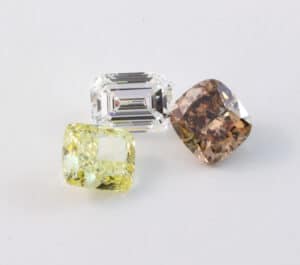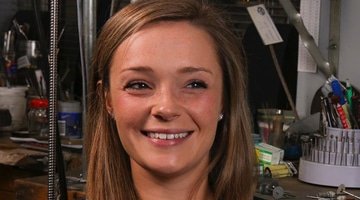 Synthetic diamonds have become more prevalent in the jewellery industry, and it is more important than ever for customers to be aware of the facts around diamonds (natural or synthetic), and for jewellers and valuers to know how to distinguish between the two. I sat down with Greg John, our Master Jeweller gemmologist and diamond technologist, and asked some questions about synthetic diamonds.
Synthetic diamonds have become more prevalent in the jewellery industry, and it is more important than ever for customers to be aware of the facts around diamonds (natural or synthetic), and for jewellers and valuers to know how to distinguish between the two. I sat down with Greg John, our Master Jeweller gemmologist and diamond technologist, and asked some questions about synthetic diamonds.
What is a synthetic diamond?
Synthetic diamonds are diamonds which have all the physical and optical properties of natural diamonds but are produced in a machine in a laboratory or factory.
What are some of the marketing terms they are sold as or referred to?
Synthetic diamonds are marketed under several terms and trade names within the retail industry, such as ‘manmade’, ‘created’ or ‘cultured’, but governing bodies within the jewellery industry (CIBJO) are now requiring that all jewellers or suppliers must disclose these stones as synthetic and label them as such (laboratory grown diamonds) without abbreviations (LBD) or fancy names. They must be disclosed for what they are – synthetic diamonds.
How are synthetic diamonds made?
They are made in a factory by a machine. The two major (current) methods of manufacture are High Pressure High Temperature (HPHT), which involves using a large pressure chamber to simulate the environment in which diamonds naturally grow, and Chemical Vapour Deposition (CVD), which is grown under less pressure via a gas and vapour solution. These diamonds are never produced as a cut gem. The final product produced appears as a flat plate or rough pebble that is then cut and faceted.
General Electric has produced synthetics since the 1950s. Why are we only aware of them now?
Synthetic diamonds were originally made to cater for the industrial and not the gemmological market and were significantly smaller in size than those today. In recent times the technology has advanced to grow larger diamonds.
Why are synthetic diamonds so cheap in comparison to natural ones?
Natural diamonds develop over millions of years in the ground and have their own unique qualities – no two diamonds are the same. Hence the larger and higher quality diamonds fetch a higher price and are more expensive than synthetics. Synthetic diamonds are created in a factory over a much shorter period and can be quickly processed. Synthetic diamonds have dropped in price due to the number flooding the market and are expected to continue to decrease in price over time compared to naturals which will only increase in value.
Other gemstones, such as ruby and emerald, have been produced synthetically. What has been the result on the price of the natural product?
No impact whatsoever. The natural gems continue to increase in price as a reflection of their rarity. By contrast, the price of synthetics has halved, then halved again as more producers emerged. The supply of synthetics is limitless – but discerning consumers are prepared to pay the price for natural gemstones.
Why spend the extra money on a natural stone?
Natural stones have their own unique characteristics, are rarer and will only become rarer over time. The number of diamond ‘pipes’ (where diamonds are found) are finite, and therefore will be mined out eventually. Synthetic diamonds, however, can continue to be made by machines for many years to come.
‘Natural stones … are rarer, and will only become rarer over time. Synthetic diamonds, however, can continue to be made by machines for many years to come’
Synthetic diamonds are often marketed as ‘greener’ for the environment. Is this correct?
The marketing of synthetic diamonds as ‘greener’ or more environmentally friendly is a claim that is sadly false. Yes… there are no holes dug in the process of growing a diamond in a factory, but the power required (most often from coal) is immense and a significant amount of water is used as well. This far exceeds the environmental cost of mining. Diamond mines have long had redevelopment programs in place to reinstate the landscape and flora once mining has ceased.
Why is it important to view a diamond in person rather than purchasing one from the internet?
You can only learn so much from the internet and purchasing from a certificate sight unseen is not a sure bet to determine the true beauty or value of a stone. Every diamond is different with its own unique brilliance, cut and inclusions. When diamonds are graded, they are graded by eye and with a loupe and can vary based on the grader’s subjectivity. When looking for a diamond, you need to know what you are looking for, be guided through the process and compare stones. As many of our clients agree, there is nothing comparable to looking into a diamond with a 10x magnification loupe! Given a choice of diamonds of varying grades from which to choose, you will easily see the difference yourself, and will pick out the best!
Can you tell the difference between a natural diamond and a synthetic diamond?
It is extremely hard to tell the difference. A qualified and trained valuer or jeweller with the correct training to operate and decipher the results will be able to distinguish between the two. It is particularly important therefore to know what and who you are buying from as synthetic diamonds are increasingly making their way into jewellery (many as small diamonds).
Do Abrecht Bird sell synthetic diamonds and why?
Abrecht Bird do not sell synthetic diamonds. Our company is not just a trader of diamonds and gemstones. Our specialty is in designing, handcrafting and manufacturing high quality fine jewellery.
Would Abrecht Bird make an item of jewellery in the workshop with a customer supplied synthetic diamond?
Yes, we will! We specialise in crafting fine quality jewellery, and this is our focus. Clients have used their own gemstones in the past for sentimental reasons to design personal and meaningful heirlooms and personal items of jewellery. We will always maintain our standards of precious metal quality and our workmanship to be of the highest standard. We create wearable art!
Please call our office and speak to our team about making an appointment or with any queries you may have. We would love to help you design your next piece of diamond jewellery!
 Kylie Beachley
Kylie Beachley
FGAA Dip DT Regt Valuer RV348
Office Manager
and

Greg John
FGAA Dip DT
Master Jeweller & Regt Valuer RV231
Coloured Diamonds
Article by Stephanie Lawton - FGAA, DIP DT Did you know that diamonds can come in almost every colour? Either naturally or with a little help from treatments? When we think of diamonds, we typically think of white or clear diamonds and the rainbow sparkle that we can...
Staff Under The Spotlight: Eleanor Hawke
Recently our staff were featured in Q&A style articles in the jewellery industry publication 'Jeweller Magazine'. Eleanor featured in the October edition. SIGNATURE PIECE: 'FLORA' SLIDER PENDANT - A slider pendant is part one of a three-piece series designed...
Stephanie & Liam’s Engagement
Here, at Abrecht Bird Jewellers, when the time comes for colleagues to get engaged, there is a lot of sneaking around and secrecy. Liam contacted Peter at the start of June to get the ball rolling with my engagement ring. Liam obviously couldn’t use his name,...



